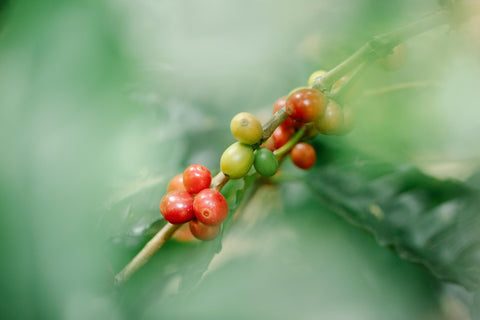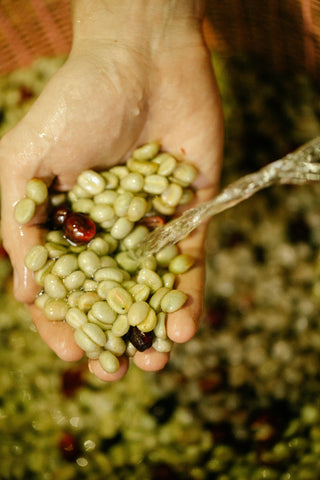Our easy guide to coffee processing
ChatHere we’re going to give you a little run down of the most common processing methods of specialty coffee and how exactly they affect the taste of your beans. This info should help you better understand what’s inside your bag, as well as steer you in the right direction when trying something new...

If you’re into specialty coffee (we hope you are if you're here), you may have noticed ‘process’ followed by a word like Natural, Washed or Honey on your coffee bag. These words detail the various processing methods of your coffee beans, which have a huge part to play when it comes to the flavour profile of your end brew. Having some background knowledge on the processing methods, as well as the origins of coffee can really help to inform your purchasing decisions, especially when most retail shelves are crammed with a bucket load of different coffees.
Here we’re going to give you a little run down of the most common processing methods of specialty coffee and how exactly they affect the taste of your beans. This info should help you better understand what’s inside your bag, as well as steer you in the right direction when trying something new. After all, there’s a lot of interesting stuff out there nowadays and as a consumer it can be hard to navigate your way through the fog!
THE COFFEE CHERRY

Before we get into the different ways coffee can be processed, you need to know a little bit about the coffee cherry itself. A lot of people don’t realise that coffee beans are actually the seeds of the coffee cherry. This is a round, commonly red, cherry-like fruit that grows on coffee bushes. These cherries are harvested, sorted and then processed, to produce green coffee beans, which roasters like ourselves source and roast before bagging and brewing.
Let’s go ahead and break the coffee cherry down from the outside layer, working in:
Outer skin (or cascara) -
It won’t be a surprise to you that this is the outermost layer of the fruit and serves to protect the flesh and seeds within. This is usually green in its unripe form and will ripen to cherry red, yellow or even pink depending on its varietal.
Pulp (or mucilage) -
This thin layer consists of the fruity fleshy body of the cherry. It’s mostly made up out of water and natural sugars but we’ll get more into that later. The mucilage is the innermost layer of the pulp and is sticky and sweet when ripe.
Parchment (or hull) -
This is the outer casing that surrounds the coffee seed itself. When this is dried it becomes paper-like, hence the name ‘parchment’.
Silver skin -
Here we have the outer protective skin of the coffee seed. This usually adheres to both seeds within the coffee cherry. This layer is usually removed naturally when roasting.
Coffee bean -
Finally we have the bean itself (you know what this is, come on now...).
Now let’s jump into the most common methods of coffee processing:
NATURAL -

Sometimes known as the ‘dry process’, natural processing is the oldest and most common form of coffee processing. With this method of processing, the coffee cherries are harvested and immediately left out to dry in their whole form with the skin-on, ‘naturally’ on flatbeds or tables in the sun.This drying process usually takes upwards of two weeks to complete and after this, the dried fruit is separated from the beans with specialist machinery.
How does this process affect the flavour?
During this process, natural fermentation occurs as the sugars within the coffee cherry impart their flavours onto the coffee beans within, over a few weeks. This sun-drying process brings out fruitier, berry-like flavours. Natural processed coffee also often has a richer, more syrupy body when compared to washed coffee.
Our Time Machine coffee from Yunnan, China, is a great example of a fruity, natural processed coffee.
WASHED -

Washed coffee processing is slightly more laborious than natural processing as it includes the extra step of (you guessed it) washing the beans. Like natural processing, the coffee cherries are first harvested and sorted but instead of leaving the cherries whole, the outer skin is first removed. The mucilage (that sticky, sugary layer we talked about earlier) is retained and so still surrounds the coffee beans themselves. This sweet layer is incredibly important as the beans are now left to ferment in water for a minimum of two days. After the fermentation process, the beans are then washed with water to remove the fleshy mucilage layer. Finally, the beans are dried, like with natural processing, on flatbeds or tables in the sun (drying can also be done with specialist machinery to speed up the process.)
How does this process affect the flavour?
Washed coffee usually has a cleaner, lighter body with more nuanced flavours. You can expect crisp, bright coffees with a higher acidity. With washed coffee you are more likely to be tasting the natural flavours of the beans themselves in their most raw form and not the processing method's affects.
Our Juicebox is a pretty classic washed coffee from the Sidamo region of Ethiopia.
HONEY / PULPED NATURAL -
Contrary to it's name, sadly there's actually no actual honey involved with honey processed coffee. This method is especially popular in South American regions like Costa-Rica due to it requiring far less water than standard washed coffee.
Honey processed coffee is pretty much a fusion of the two prior methods. With honey processing after the cherries are harvested, the main pulp of the cherry is removed but the thinner mucilage layer remains intact. The beans are then dried exactly like natural and washed processes. The sticky sweet mucilage layer helps the beans develop a sweet honey like profile, hence it's name. After drying, the mucilage layer is then finally removed with a dry milling process rather than with water.
It's also worth noting that there are several different types of honey processing. These are, White Honey, Yellow Honey, Red Honey and Black Honey. The darker the colour, the higher percentage of mucilage that remains on the beans during the drying process.
How does this process affect the flavour?
Honey processed coffee often has the body, depth and sweetness of natural coffees but with a well balanced, more muted acidity. You can expect a fairly clean cup and depending on the type of honey processing, it can taste more like a natural or more like a washed coffee. For instance, Black Honey processing is more likely to have a similar profile to a natural coffee because of the higher quantity of mucilage left on the beans during fermentation and drying.
ANAEOROBIC -
Anaerobic processing is a newer method of coffee processing that continues to grow more and more popular in the specialty coffee industry. Anaerobic essentially means the absence of oxygen. There are several different ways of producing Anaerobic coffee but let's focus one of the most common methods.
The coffee cherries are harvested before being placed into sealed, pressurised tanks with CO2 gas valves that release any excess gasses. This is where the fermentation process occurs without oxygen. This forces the juices, sugars and acids into the beans under great pressure. Interestingly, you can have Anaerobic natural, washed and honey process coffees. These are all produced as they would be usually but fermentation occurs without or with minimal oxygen. This unique environment within the tanks allows for the development of different bacterias and yeast that wouldn't usually be present during the fermentation process.
How does this process affect the flavour?
One of the reasons why Anaerobic processed coffee has boomed in popularity is because of the whacky, unusual flavours that can be produced with this method. Anaerobic coffee can commonly have complex, nuanced flavour profiles with a more syrupy body.
Our Snow Day coffee is a great example of Anaerobic coffee and has a funky cranberry jam-like acidity.
WHAT'S NEXT?
Year by year the coffee industry continues to push new boundaries when it comes to processing. Producers have been tinkering and experimenting with different fermentation techniques that can lead to some pretty crazy end products. (We tried this Colombian Advanced Aenarobic the other day and it blew us away!)
You may have heard of carbonic maceration and lactic fermentation processing. These methods are far more complex than common methods as they contain many more variables for the producer to juggle in order to get something that may or may not taste good! These methods primarily target a more unusual flavour pallet and because of this can rise or fall in demand quite drastically. It's worth noting that although these processing methods are growing in popularity, it still makes up a rather niche segment of the overall coffee market. Still, it's super exciting to see farmers and producers creating new unexpected flavour profiles with pioneering techniques.
We hope that this post has given you a good insight into the most common coffee processing methods. Hopefully you now have some basic knowledge that can help you know a bit more about what's inside your bag and why it tastes that way! If you'd like some more info or would simply like to have a chat about coffee, feel free to pop into our roastery in Deptford and speak to a member of our team :)
Cheers guys,
James x